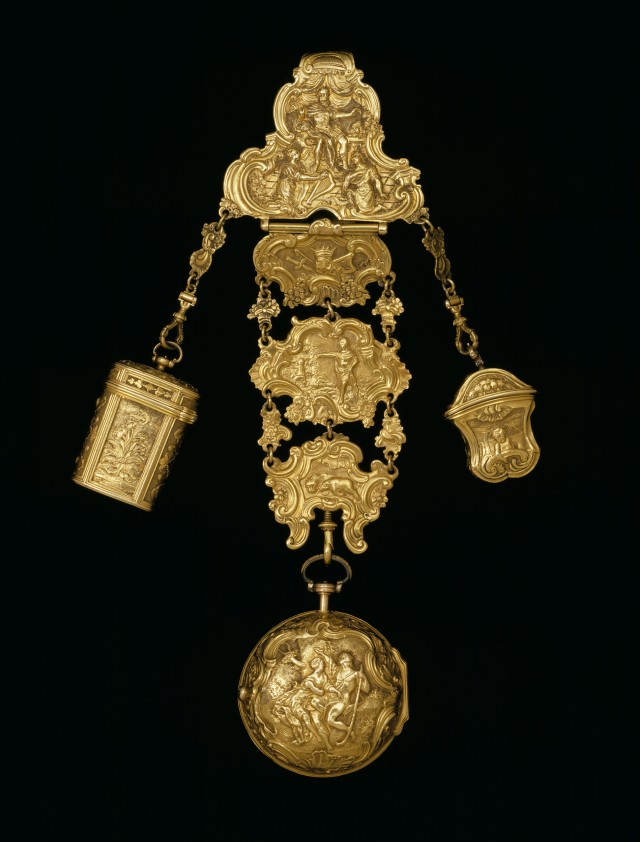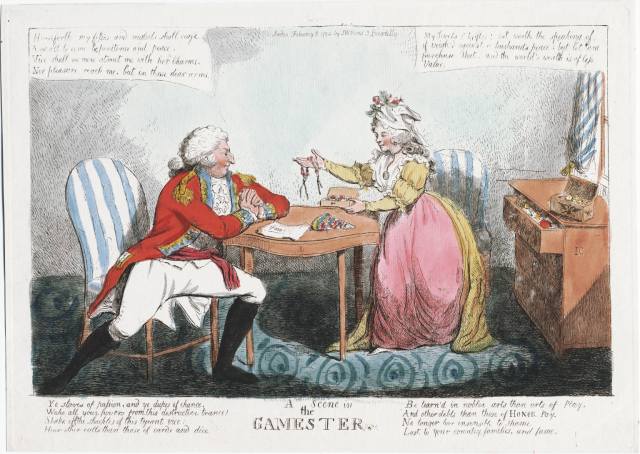
How many of us can honestly say that we don’t feel good when wearing a beautiful piece of jewellery. The Georgians were no different, the bolder the better in many cases. So we thought we would take a look at the ‘bling’ of the day.

There were certain items of jewellery that were designated for certain times of the day. Day wear would consist of a necklace, small understated rings and the most important item which arguably would still be useful today – the chatelaine or chain, known as ‘equipage’ until the 1830’s, as shown below which would be attached to the waist of the dress.

Today this item seems to have been replaced by the familiar ‘bottomless’ handbag. In the 18th century is would have worn about the waist and would have been used to hold everything you could have possibly needed for the day – scissors, a thimble case, needles, a small purse, seals, a watch, a small booklet to write notes on, a pencil, etc.

Eighteenth-century gents would display their status by wearing shoe buckles and buttons studded with gems such as these.

Evenings required a completely different type of jewellery – diamonds were the order of the day, the bigger and brighter the better, usually set in silver. Diamonds were often mounted in silver, rather than gold, with the aim being to enhance the stone’s colour and would have been an essential part of court life. To be at the height of fashion you would wear Girandole earrings. These featured a central bow from which hung three dangling jewels that resembled the chandeliers of the period. For those who chose not to have pierced ears, the Georgian era saw the advent of the clip-on earring.

During the French Revolution many women chose to wear a red ribbon as a choker in support of friends and family who had died during the revolution, or as a sign of their own close call with death. For those more affluent then rubies would have been the equivalent, both indicative of the blood shed at executions.

This item from the British Museum was too fascinating not to include. The description reads:
Heart shaped pendant locket with a lock of hair, traditionally said to be that of Marie Antoinette, set under glass or rock-crystal with an inscribed card and mounted in a gold filigree setting. A small gold padlock is suspended from the base with a key on a chain attached to the suspension loop. The filigree in the form of tight spiral discs forming ‘spectacles’ shapes, placed within the flat wire rim.
Inscription Content
A lock of hair of MARIE ANTOINETTE, Queen of FRANCE given by her to Lady Abercorn by whom it was given to her sister Lady Julia Lockwood, whose daughter Lady Napier gave it to W.S. 1853
Inscription Comment
The inscription is wrongly transcribed in the catalogue of the Hull Grundy Gift: Lady Abercorn is given as Lady Abercrombie.
For more information about this item use the highlighted link to the British Museum web page.
Moving on to possibly the most macabre items of jewellery, we take a brief look at mourning rings. In many wills that we have read it seems commonplace for the deceased to leave enough money for some sort of mourning ring to be purchased as a keepsake, usually bearing the name and date of death of the person, and possibly an image of them, or a motto.


And finally we take a look at an item of jewellery that seems unlikely ever to return to fashion – Lover’s eye brooches or eye miniatures. It is reputed that they became popular in the late 1780’s when the Prince of Wales decided to send Maria Fitzherbert a token of his love for her. The idea that he should wish to do such a thing was frowned upon, so he commissioned Cosway simply to paint only the eye to preserve anonymity.

Our post would not be complete without including something light hearted from the Lewis Walpole Library, so if finances were running low due to gambling debts a lady could always sell her jewels!




Pingback: Fugs and Pieces, October 2nd, 2015 | hello us daily | Fashion Trend Updates